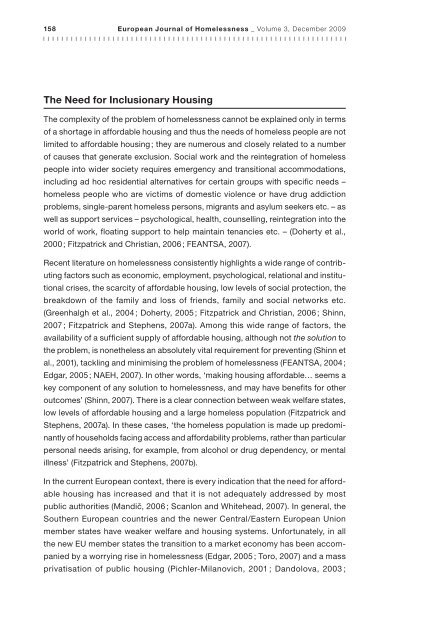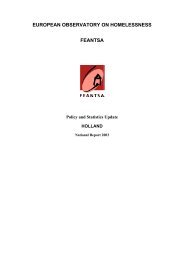Part A - Feantsa - Horus
Part A - Feantsa - Horus
Part A - Feantsa - Horus
Create successful ePaper yourself
Turn your PDF publications into a flip-book with our unique Google optimized e-Paper software.
158 European Journal of Homelessness _ Volume 3, December 2009<br />
The Need for Inclusionary Housing<br />
The complexity of the problem of homelessness cannot be explained only in terms<br />
of a shortage in affordable housing and thus the needs of homeless people are not<br />
limited to affordable housing ; they are numerous and closely related to a number<br />
of causes that generate exclusion. Social work and the reintegration of homeless<br />
people into wider society requires emergency and transitional accommodations,<br />
including ad hoc residential alternatives for certain groups with specific needs –<br />
homeless people who are victims of domestic violence or have drug addiction<br />
problems, single-parent homeless persons, migrants and asylum seekers etc. – as<br />
well as support services – psychological, health, counselling, reintegration into the<br />
world of work, floating support to help maintain tenancies etc. – (Doherty et al.,<br />
2000 ; Fitzpatrick and Christian, 2006 ; FEANTSA, 2007).<br />
Recent literature on homelessness consistently highlights a wide range of contributing<br />
factors such as economic, employment, psychological, relational and institutional<br />
crises, the scarcity of affordable housing, low levels of social protection, the<br />
breakdown of the family and loss of friends, family and social networks etc.<br />
(Greenhalgh et al., 2004 ; Doherty, 2005 ; Fitzpatrick and Christian, 2006 ; Shinn,<br />
2007 ; Fitzpatrick and Stephens, 2007a). Among this wide range of factors, the<br />
availability of a sufficient supply of affordable housing, although not the solution to<br />
the problem, is nonetheless an absolutely vital requirement for preventing (Shinn et<br />
al., 2001), tackling and minimising the problem of homelessness (FEANTSA, 2004 ;<br />
Edgar, 2005 ; NAEH, 2007). In other words, ‘making housing affordable… seems a<br />
key component of any solution to homelessness, and may have benefits for other<br />
outcomes’ (Shinn, 2007). There is a clear connection between weak welfare states,<br />
low levels of affordable housing and a large homeless population (Fitzpatrick and<br />
Stephens, 2007a). In these cases, ‘the homeless population is made up predominantly<br />
of households facing access and affordability problems, rather than particular<br />
personal needs arising, for example, from alcohol or drug dependency, or mental<br />
illness’ (Fitzpatrick and Stephens, 2007b).<br />
In the current European context, there is every indication that the need for affordable<br />
housing has increased and that it is not adequately addressed by most<br />
public authorities (Mandič, 2006 ; Scanlon and Whitehead, 2007). In general, the<br />
Southern European countries and the newer Central/Eastern European Union<br />
member states have weaker welfare and housing systems. Unfortunately, in all<br />
the new EU member states the transition to a market economy has been accompanied<br />
by a worrying rise in homelessness (Edgar, 2005 ; Toro, 2007) and a mass<br />
privatisation of public housing (Pichler-Milanovich, 2001 ; Dandolova, 2003 ;




